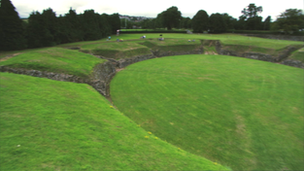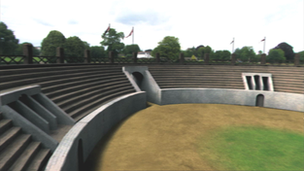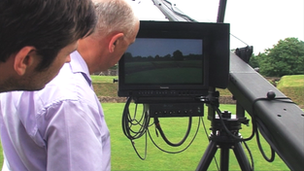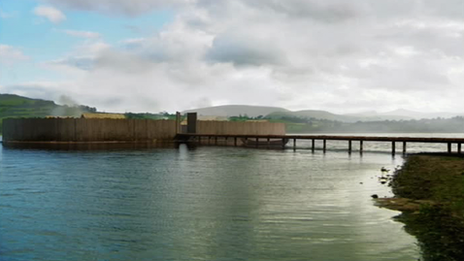The Story of Wales: Rebuilding historic monuments for the screen
- Published
How do you conjure up a majestic Roman amphitheatre from a set of 2,000-year-old stone ruins? How do you faithfully recreate a 9th Century wooden settlement on an overgrown island in the middle of a modern-day lake?
These were just two of the challenges facing the makers of BBC Wales' new history series, The Story of Wales.
The six-part series traces the history of the nation from the Ice Age to the information age.
It features computer-generated recreations of 28 ancient, crumbling or disappeared Welsh historic landmarks, ranging from the Roman settlement in Caerleon, near Newport, to the 19th Century slums of Merthyr Tydfil.
To ensure each recreation was done as accurately as possible, the production team sought advice from the leading experts on each location.
"We went to the best source in each case," said Llinos Williams, production manager on the series, which was made for BBC Wales by Green Bay.
Llyr Williams and Christian Lett of Pontypridd-based animation production company Dinamo were brought on board to help produce the CGI sequences.
'Factually accurate'
For episode three, the design team was tasked with producing a virtual reconstruction of the 12th Century Strata Florida Abbey near Tregaron in Ceredigion, and so turned to Cadw.
"Cadw had their own research going on into what Strata Florida originally looked like," said Ms Williams.

This is how the amphitheatre in Caerleon looks today
"Professor David Austin, who works with Cadw, is heading their research project into Strata Florida and he was incredibly helpful in getting us to the right structure.
"We were even able to make sure that the window panels were factually accurate."
To reconstruct the AD90 Roman settlement at Caerleon in episode one, the team drew inspiration from a painting that National Museum Wales had been putting together with Cardiff University.
"Llyr and Christian would go out on site with the relevant episode director at each location and we put them in contact with academics," explains Ms Williams.
"They then did their own research, drawing on information sources from across the world to help them piece together their images.
"They looked at an amphitheatre in Rome to get an idea of the textures for the building materials for the Caerleon amphitheatre."

How it looked then. Around 6,000 Romans would have gathered to watch gladiatorial contests
The result was a remarkable sequence in which series presenter Huw Edwards walks in the present-day stone ruins of the amphitheatre.
As he walks into the arena it morphs into the amphitheatre as it would have looked like in AD90, when up to 6,000 people would have gathered to watch gladiatorial games against man and beast.
"That shot, which last 30 seconds, took us about a month to complete, I'd say," said Llyr Williams.
"A lot of people knew about the amphitheatre there but what the CGI does is put across the true scale of the place," added Llinos Williams.
Completing the CGI element of the series, which also features 38 dramatisations of key scenes from Welsh history, was a lengthy process.
"It started in May 2011 and ended in December," said Ms Williams. "There were difficulties. The earlier you go in history, of course, the less documentation there is.

The CGI team worked on location with each episode director and a range of academic experts
"So an element of it is interpretation. But it's academic interpretation rather than us going off on a flight of fancy.
"And in retelling Welsh history it really gives you a sense of being there, a sort of living history if you like."
Her favourite sequence, she said, was a sequence in episode four recreating the 19th Century industrial hub of Swansea, complete with smoke and smog.
"We went to Swansea Bay to film and, of course, on the day we filmed it was a bright and beautiful day.
"But when the CGI image was laid on top the scene was totally transformed.
"To me it was like being there. It's a real wow moment and brings history to life, especially for younger viewers."
The Story of Wales: England and Wales can be seen on BBC One Wales on Monday, 5 March at 21:00 GMT. The series is available on iPlayer.
A behind the scenes programme, Making The Story of Wales: From The Stone Age To The Tudors, can be seen on BBC Two Wales on Monday, 5 March at 22:00 GMT.

The design team also recreated a 9th Century royal residence for the Welsh kingdom of Brycheiniog at Llangorse lake
- Published1 March 2012
- Published27 February 2012
- Published19 January 2012